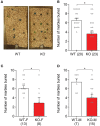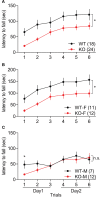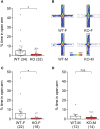Sex-Dependent Motor Deficit and Increased Anxiety-Like States in Mice Lacking Autism-Associated Gene Slit3
- PMID: 30483073
- PMCID: PMC6243047
- DOI: 10.3389/fnbeh.2018.00261
Sex-Dependent Motor Deficit and Increased Anxiety-Like States in Mice Lacking Autism-Associated Gene Slit3
Abstract
Altered neuronal connectivity has been implicated in the pathophysiology of Autism Spectrum Disorder (ASD). SLIT/ROBO signaling plays an important role in developmental processes of neuronal connectivity, including axon guidance, neuronal migration, and axonal and dendritic branching. Genetic evidence supports that SLIT3, one of the genes encoding SLITs, is associated with ASD. Yet the causal link between SLIT3 mutation and autism symptoms has not been examined. Here we assessed ASD-associated behaviors in Slit3 knockout (KO) mice. Our data showed that Slit3-KO mice exhibited reduced marble burying behaviors but normal social behaviors. In addition, Slit3-KO mice displayed hypolocomotion in the open field test and impaired motor coordination in the rotarod test. Anxiety-like behaviors were mainly observed in female KO mice assessed by three types of behavioral tests, namely, the open field test, elevated plus maze test, and light/dark box test. No differences were observed between KO and wildtype mice in recognition memory in the novel object recognition test or depression-like behavior in the tail suspension test. Taken together, loss of Slit3 may result in disrupted neural circuits related to motor function and increased anxiety-like states, which are co-occurring symptoms in ASD.
Keywords: Slit3; anxiety; autism(ASD); hypolocomotion; motor coordination.
Figures








Similar articles
-
Comprehensive behavioral phenotyping of a new Semaphorin 3 F mutant mouse.Mol Brain. 2016 Feb 9;9:15. doi: 10.1186/s13041-016-0196-4. Mol Brain. 2016. PMID: 26856818 Free PMC article.
-
NEXMIF/KIDLIA Knock-out Mouse Demonstrates Autism-Like Behaviors, Memory Deficits, and Impairments in Synapse Formation and Function.J Neurosci. 2020 Jan 2;40(1):237-254. doi: 10.1523/JNEUROSCI.0222-19.2019. Epub 2019 Nov 8. J Neurosci. 2020. PMID: 31704787 Free PMC article.
-
Replicable in vivo physiological and behavioral phenotypes of the Shank3B null mutant mouse model of autism.Mol Autism. 2017 Jun 15;8:26. doi: 10.1186/s13229-017-0142-z. eCollection 2017. Mol Autism. 2017. PMID: 28638591 Free PMC article.
-
Impairment of social and emotional behaviors in Cadm1-knockout mice.Biochem Biophys Res Commun. 2010 Jun 4;396(3):703-8. doi: 10.1016/j.bbrc.2010.04.165. Epub 2010 May 5. Biochem Biophys Res Commun. 2010. PMID: 20450890
-
Sustained lentiviral-mediated overexpression of microRNA124a in the dentate gyrus exacerbates anxiety- and autism-like behaviors associated with neonatal isolation in rats.Behav Brain Res. 2016 Sep 15;311:298-308. doi: 10.1016/j.bbr.2016.05.033. Epub 2016 May 17. Behav Brain Res. 2016. PMID: 27211062
Cited by
-
VIP/PACAP-Based Drug Development: The ADNP/NAP-Derived Mirror Peptides SKIP and D-SKIP Exhibit Distinctive in vivo and in silico Effects.Front Cell Neurosci. 2020 Jan 14;13:589. doi: 10.3389/fncel.2019.00589. eCollection 2019. Front Cell Neurosci. 2020. PMID: 31992971 Free PMC article.
-
Candidate Gene and Genome-Wide Association Studies for Circulating Leptin Levels Reveal Population and Sex-Specific Associations in High Cardiovascular Risk Mediterranean Subjects.Nutrients. 2019 Nov 13;11(11):2751. doi: 10.3390/nu11112751. Nutrients. 2019. PMID: 31766143 Free PMC article.
-
Sex-Dependent Social and Repetitive Behavior and Neurochemical Profile in Mouse Model of Autism Spectrum Disorder.Metabolites. 2022 Jan 12;12(1):71. doi: 10.3390/metabo12010071. Metabolites. 2022. PMID: 35050193 Free PMC article.
-
Combined targeting of TCF7L1/2, PTEN, CDK6, and BCCIP by microRNA miR-29c-3p is associated with reduced invasion and proliferation of endometriotic cells.Reprod Med Biol. 2025 Mar 25;24(1):e12645. doi: 10.1002/rmb2.12645. eCollection 2025 Jan-Dec. Reprod Med Biol. 2025. PMID: 40135061 Free PMC article.
-
Effects of Paternal Preconception Vapor Alcohol Exposure Paradigms on Behavioral Responses in Offspring.Brain Sci. 2020 Sep 22;10(9):658. doi: 10.3390/brainsci10090658. Brain Sci. 2020. PMID: 32971974 Free PMC article.
References
-
- Abu-Dahab S. M. N., Skidmore E. R., Holm M. B., Rogers J. C., Minshew N. J. (2013). Motor and tactile-perceptual skill differences between individuals with high-functioning autism and typically developing individuals ages 5-21. J. Autism Dev. Disord. 43, 2241–2248. 10.1007/s10803-011-1439-y - DOI - PMC - PubMed
LinkOut - more resources
Full Text Sources
Molecular Biology Databases
Research Materials

